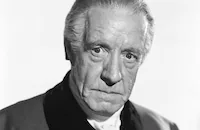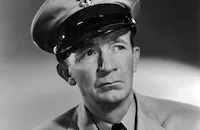Three Godfathers

Brief Synopsis
Cast & Crew
Richard Boleslawski
Chester Morris
Lewis Stone
Walter Brennan
Irene Hervey
Sidney Toler
Film Details
Technical Specs

Synopsis
Just before Christmas in the late nineteenth century, Bob Sangster, a cynical renegade, returns to his home town of New Jerusalem to rob the local bank. Accompanying Bob are James "Doc" Underwood, a tubecular outcast with the soul of a philosopher, Sam "Gus" Bartow, an illiterate drifter, and Pedro, a troubadour. In town, Bob meets Molly, with whom he was once in love, but who now is engaged to banker Frank Benson. Bob offers Molly his mother's watch as a wedding present, but when he accuses her of marrying Frank to forget him, Molly, who had thought that she still loved Bob, angrily returns the watch. Bob then trades the watch for drinks at the bar, but tricks the bartender into returning it by telling him that it was his dead mother's legacy. The next morning, while the townsfolk are busy at a pie sale to raise money for charity, the four outlaws rob the bank. A group of armed citizens puruse them into the desert, and in the exchange of gun fire, Pedro is killed and Doc wounded. In the inferno of the desert, the three come upon a poisoned water hole. On their way to the next water hole, they find the body of a man, and at the now dried-up water hole, they find a half-dead woman and her infant son. The woman, Mrs. George Marshall, tells them that her husband had gone to search for water. Taking pity on the woman, Doc tells her that her husband reached New Jerusalem and sent them to help her. With her dying breath, she begs them to care for her child, but Bob refuses to travel with the baby and resolves to make the eighty-eight mile trek to the next water hole by himself. The next morning, the they discover that their horses have died in the night from drinking poisoned water. Unable to walk the distance to the next water hole, they decide to turn back to New Jerusalem. After combining the last drops of their water, Bob divides up the last three cans of the baby's milk, but Doc offers to buy back Bob's can with his share of the bank loot. Despite his weakened condition, Doc carries the baby until he collapses and is near death. Gus wants to stay with him, but Doc convinces him to continue on with the infant. After writing wills for himself and Gus, Doc bequeaths Gus one of his books and then shoots himself while reciting the words "out, out, sweet candle" from Macbeth . Gus and Bob then continue their arduous journey back to New Jerusalem when Gus, half mad with heat and thirst, takes Doc's book and wanders off into the desert. Bob awakens from a short nap to find the note that Doc had written for Gus, pleading with Bob take care of the child. Bob ignores Gus's plea, then picks up the money bags and leaves the baby behind, but when he sees a rattle snake slithering toward the infant, he shoots the snake and returns to give the child the last drop of water. Five-and-a-half miles from his destination, Bob collapses, unable to continue, and prays to God to help the baby. Soon after, Bob sees the poisoned water hole and, realizing that the one hour that it will take the poison to kill him will give him enough time to reach New Jerusalem, he drinks heartily. Bob enters town to the strains of the church congregation singing Christmas hymns and staggers into the church, much to the surpise of the townsfolk. After placing the infant in Molly's arms, Bob collapses and dies. The baby grasps Bob's watch in his fist, and when a member of the congregation wonders where Bob stole it, Molly replies that he did not steal it, the watch belonged to his mother.

Director

Richard Boleslawski
Cast

Chester Morris

Lewis Stone

Walter Brennan
Irene Hervey

Sidney Toler

Dorothy Tree
Roger Imhof
Willard Robertson
Robert Livingston
John Sheehan
Joseph Marievsky
Victor Potel
Helen Brown
Harvey Clark
Virginia Brissac
Jean Kirchner
Gertrude Sutton

Leonid Kinsky
Sam Mcdaniel
Minerva Urecal
Dewey Robinson
Charles Stevens
Sherry Hall
Richard Cramer
John Wallace
Emanuel Turner
Bernard Carr
Crew
Dr. William Axt
Cedric Gibbons
James Havens
Joseph L. Mankiewicz
Edward E. Paramore Jr.
Joseph Ruttenberg
Manuel Seff
Douglas Shearer
Frank Sullivan
Dolly Tree
Edwin B. Willis
Dolph Zimmer

Videos
Trailer
Hosted Intro
Film Details
Technical Specs

Articles
Three Godfathers (1936)
Three Godfathers, also known by its reissue title, Miracle in the Sand, was released during a relatively strange era for westerns. The early 1930s saw a huge surge in the quality and quantity of B-movie western productions, but the opposite was true for major studios' westerns, remaining so for most of the decade. In fact, the big budget western didn't experience a renaissance until the 1939 release of John Ford's Stagecoach. Until that time, the major studios virtually ignored westerns. But during this dry spell for the western, there were some noteworthy titles. Frontier Marshall and The Bad Man of Brimstone were bright spots, but they were largely shot on a backlot, with relatively low budgets.
Three Godfathers was produced by the decade's greatest production studio, Metro-Goldwyn-Mayer, even though MGM wasn't known for producing westerns. The fact that the studio made Three Godfathers is all the more remarkable in that it was produced during a time when big budget westerns weren't popular and the Great Depression severely strained studio bank accounts, thus making risky ventures all the more rare. Three Godfathers is also unique because it takes place in the arid and desolate heat of the American Southwestern desert. MGM usually eschewed such a setting for its movies, preferring instead the controlled confines of a studio indoor set or faraway exotic locales, such as the jungles of Tarzan Escapes (1936) or the Chinese landscapes in The Good Earth (1937).
Three Godfathers is equally noteworthy for its director, Richard Boleslawski (AKA Boleslawsky, AKA Boleslavski). Three Godfathers was his first and only western, and a remarkable departure from his usual studio fare. Boleslawski was hired by Irving Thalberg and came to MGM to work as a screenwriter, based on the strength and reputation of his former literary career on the New York stage. Boleslawski was eventually assigned to replace Charles Brabin as director of Rasputin and the Empress (1932). Ethel Barrymore, making her first appearance in a sound film, knew Boleslawski from the New York theatre world, and had insisted on the change of directors.
Director: Richard Boleslawski
Producer: Joseph L. Mankiewicz
Screenplay: Peter B. Kyne (story), Edward E. Paramore Jr., Manuel Seff
Cinematography: Joseph Ruttenberg
Editor: Frank Sullivan
Art Direction: Cedric Gibbons
Music: William Axt
Cast: Chester Morris (Bob), Lewis Stone (Doc), Walter Brennan (Gus), Irene Hervey (Molly), Sidney Toler (Professor Snape)
BW-82m. Close captioning.
by Scott McGee

Three Godfathers (1936)
Quotes
Trivia
Notes
Peter B. Kyne's short story "Broncho Billy and the Baby," which appeared in The Saturday Evening Post in 1910, is identified in some sources as the basis for his novel The Three Godfathers. The novel first appeared in the same magazine on November 23, 1912. According to various news items in Daily Variety and Hollywood Reporter, Madge Evans was originally cast as Molly, and Chic Sale was cast as Gus. Portions of the film were shot on location in Mojave, California. Although onscreen credit for the role of the baby goes solely to Jean Kirchner, the Call Bureau Cast Service and the Motion Picture Herald review credit "The Kirschner Twins." A news item in Hollywood Reporter just prior to the start of filming notes that two sets of twins were hired to speed up production of the picture, but names neither. Other screen adaptations of Kyne's story include a 1916 Bluebird film directed by Edward J. Le Saint and starring Harry Carey and Stella Razeto, a 1919 Universal picture called Marked Men directed by John Ford that also starred Carey (see AFI Catalog of Feature Films, 1911-20;F1.4453 and F1.2823); a 1930 Universal picture called Hell's Heroes, directed by William Wyler and starring Charles Bickford (see AFI Catalog of Feature Films, 1921-30; F2. 2414); and a 1948 M-G-M picture called Three Godfathers, again directed by Ford, and starring John Wayne, Pedro Armendariz and Harry Carey, Jr. A television movie version entitled The Godchild appeared on the ABC network in 1974, directed by John Badham and starring Jack Palance.
















